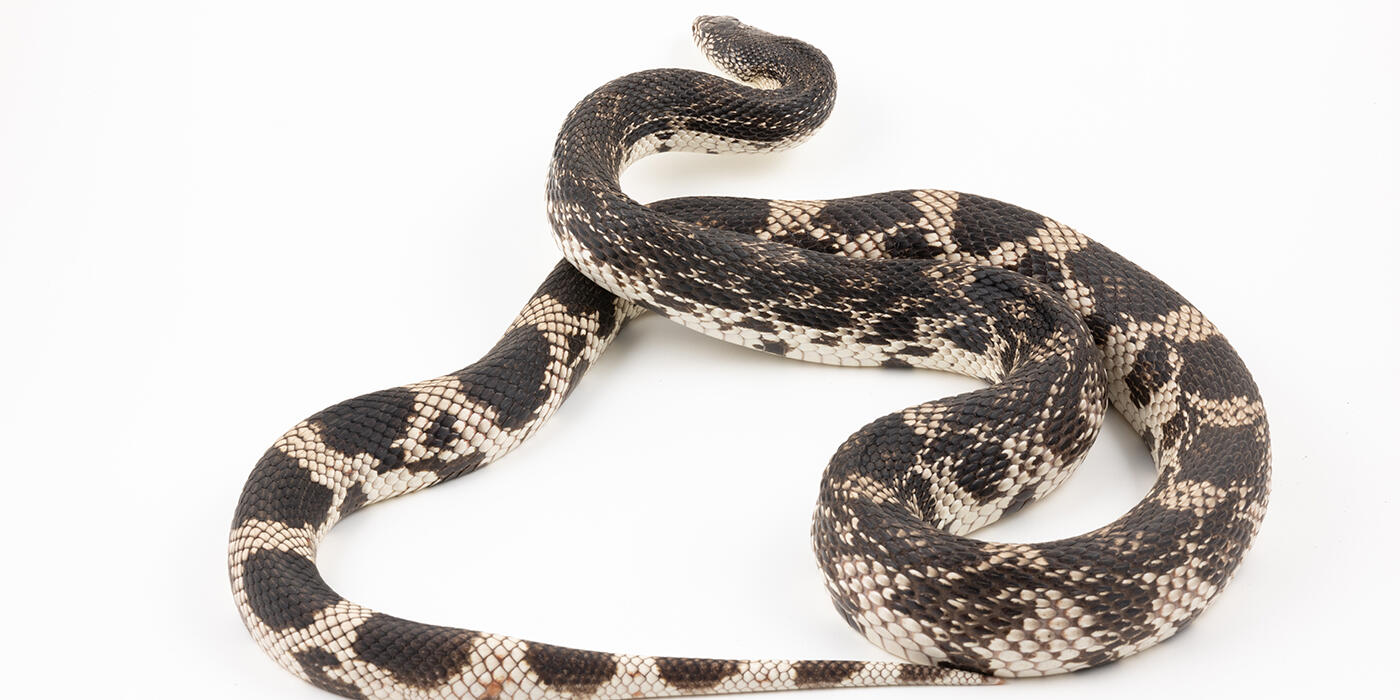Physical Description
Northern pine snakes have a distinct head that mirrors the shape of a turtle's due to its small size relative to the snake's body, as well as its pointed snout. Unlike many North American snakes, it has four prefrontal scales, which could suggest a difference in its digging behavior. The snake's pointed snout and enlarged rostral scale help it dig more efficiently, and it spends the majority of its time underground in burrows. By remaining underground, they can avoid uncomfortable temperatures and predators, search for prey and build their nests.
The northern pine snake hibernates underground throughout the winter. It emerges from its winter hibernation in late March or April and typically remains active until late October or November, though it may aestivate—enter a period of dormancy similar to hibernation—in the summer months. This snake is primarily diurnal, though some are also active at night.
There are four subspecies of pine snake: the northern pine snake, the black pine snake, the Florida pine snake and the bull snake. The northern pine snake has a black or dark brown pattern along its back. Its belly is white, with rows of black dots along either side. All members of the genus Pituophis have mimicry adaptations. A small filament in the mouth allows them to loudly hiss. Coupled with their tendency to vibrate their tail and lunge at predators, it creates a formidable defense display reminiscent of a rattlesnake.
Size
Native Habitat
The northern pine snake's range includes New Jersey, the western Appalachian mountains of Virginia, North Carolina, southern Kentucky, Tennessee, northern Alabama, northern Georgia, the piedmont area of southern North Carolina and nearly all of South Carolina. Throughout its range, this snake is nearly always associated with dry upland forests, most often with pine woods. It is also found in sandy, dry, coniferous forests.
Within these habitats, pine snakes require forest openings with drained, sandy soils for nesting and basking. Summer den sites are typically located in clearings near fallen logs. Winter hibernation refuges are located in nearby areas providing more vegetation cover and leaf litter. When active, they are usually found on the ground but may occasionally climb into low bushes or trees.
Food/Eating Habits
Reproduction and Development
Pine snakes reach sexual maturity at about 3 years old and will then breed once per year. Generally, breeding season begins in April and ends in May, but detailed information on breeding is limited to only a few subspecies. Males of various subspecies engage in combat during the breeding season, likely as a display of their dominance. Females dig a burrow in sandy soil, using their necks to scoop out the soil until they reach a layer with the right moisture content. The burrows are deep, sloping downard, then reising slightly and ending in a chamber where the female lays the eggs. Several females may use the same chamber.
Studies indicate that females use the same egg-laying site each year but dig new burrows. They lay small clutches with about 8 eggs of relatively large size. Incubation typically lasts 51 to 100 days. There is no parental care once the young hatch. They are born in the middle of summer and typically emerge measuring 1.5 feet (.3 to .45 meters). The juveniles have a dull coloration until they begin to shed, at which point they develop brighter colors.
Conservation Efforts
The northern pine snake is not assessed by the International Union for Conservation of Nature, but pine snakes as a whole are considered a species of least concern by the IUCN Red List. There is an overall trend of population decline for this animal, and New Jersey lists the pine snake as threatened.
The state's assessment also speculates that populations have been extirpated in West Virginia and Maryland, though it is sometimes difficult to survey for pine snakes, because they are often hidden underground.
Habitat loss and degradation is the prevailing threat to pine snakes, especially where range coincides with population centers. As suburbs and cities continue to expand, the pine-oak habitat northern pine snakes rely on is removed and altered. With human encroachment comes increased encounters between human and pine snakes, which often leads to the killing of the snake. Road kills and collection for use as pets are also becoming more common. Pine snakes are still present in protected areas, such as New Jersey's pinelands.
Within its range, some subpopulations of northern pine snakes are disconnected from others due to manmade structures, such as roads and buildings, that limit the movement of individuals. This is of special concern in New Jersey, where the snake is threatened.
Throughout its range, the pine snake can be extremely beneficial to humans, as a control on pests, such as mice and other rodents. Increasing awareness of this species can help build an appreciation for the northern pine snake, a frequently misunderstood animal that is vulnerable to human encroachment.
Help this Species
Reduce, reuse and recycle — in that order! Cut back on single-use goods, and find creative ways to reuse products at the end of their life cycle. Choose recycling over trash when possible.
If you see a snake in the wild, leave it alone and encourage others to do the same. Don’t assume it is a venomous species, and don’t attack it if it doesn’t pose a threat to your safety. Tell your friends and family about the eco-services that snakes provide, such as keeping rodent populations in check.
Share the story of this animal with others. Simply raising awareness about this species can contribute to its overall protection.
Smithsonian's National Zoo and Conservation Biology Institute. (n.d.). Northern pine snake. Retrieved January 17, 2026, from https://nationalzoo.si.edu/animals/northern-pine-snake
Animal News




